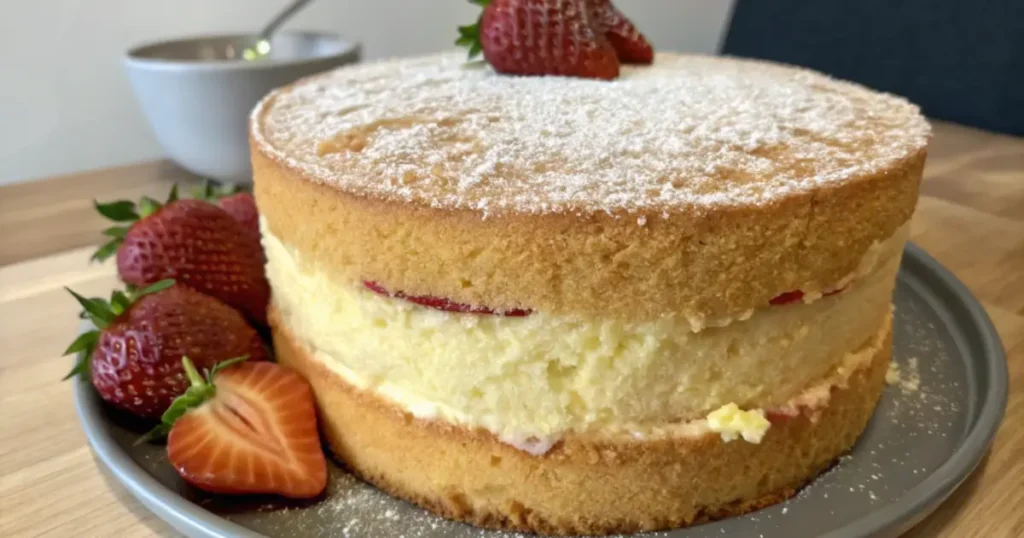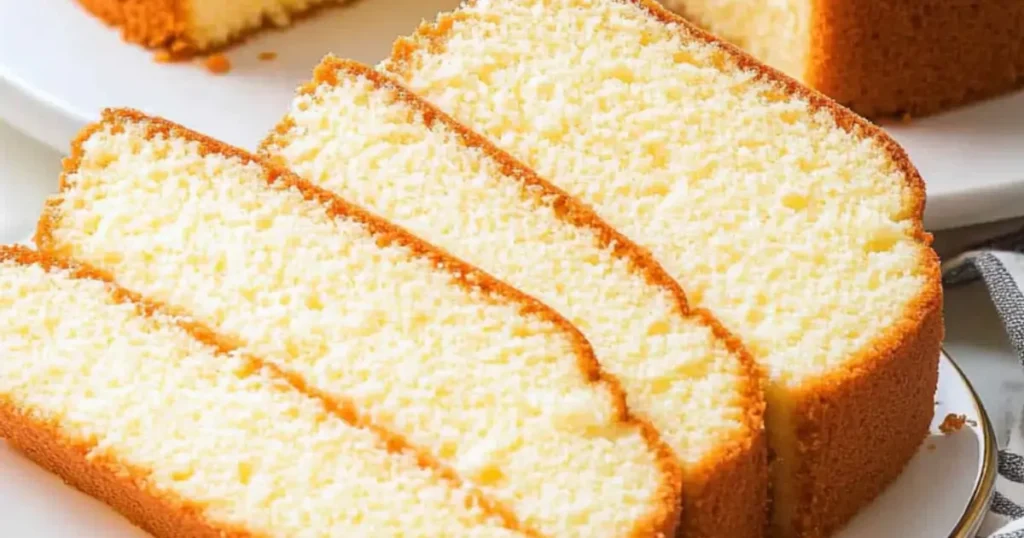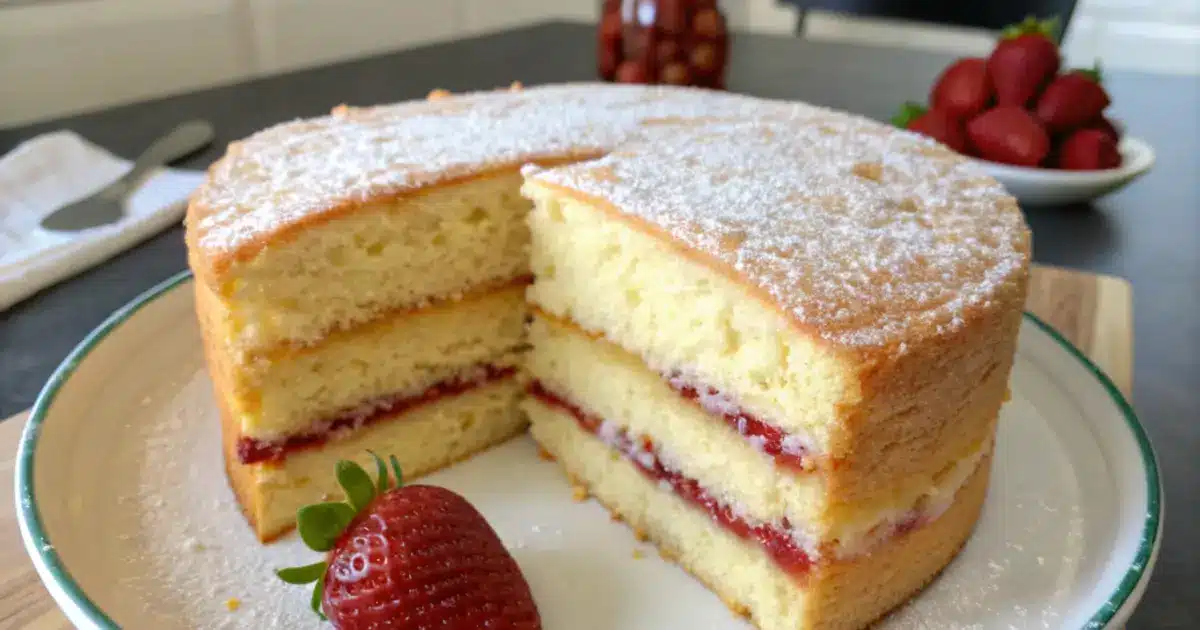Moist cakes are the hallmark of a great baker, but achieving that perfect level of softness and richness can feel elusive. Whether it’s for a birthday celebration, a dinner party, or just a sweet indulgence at home, no one wants to bite into a dry cake. So, how do you keep a cake super moist? In this article, we’ll unravel the secrets to baking irresistibly moist cakes, from choosing the right ingredients to mastering storage techniques. Let’s dive in and confirms every slice of your cake stays tender, flavorful, and utterly satisfying.
Table of Contents
How to Keep a Cake Super Moist
A moist cake isn’t just about taste—it’s about texture, appearance, and the overall experience of each bite. Let’s Innovate why moisture is so crucial and uncover common mistakes that lead to dry cakes.
The Role of The Role of Moisture in Cake Texture
Moisture is the lifeblood of a perfect cake. It determines the softness of the crumb, prevents crumbling, and confirms that every bite melts in your mouth. Moisture retention also increase flavor, allowing ingredients like cocoa or vanilla to shine. When a cake is too dry, it feels dense, crumbly, and frankly, unappealing.
How does moisture do all this? The answer lies in the interplay of fats, sugars, and liquids in the batter. These components trap water molecules and keep the structure soft and tender during baking. If even one element is off balance—too much flour, too little fat, or overbaking—the cake loses its moisture, becoming dry and unappetizing.
Common Causes of Dry Cakes
Understanding what leads to dryness is half the battle. Here are some of the most common culprits:
- Overbaking: Leaving your cake in the oven too long is a sure-fire way to dry it out. Heat causes moisture to evaporate, leaving behind a parched crumb.
- Incorrect Ingredient Ratios: Too much flour or too little fat can interrupt the balance needed for a moist cake. Measuring ingredients accurately is critical.
- Mixing Errors: Overmixing the batter develops gluten, leading to a denser, tougher texture that feels dry.
- Insufficient Liquid: Whether it’s water, milk, or buttermilk, liquids are essential for creating a soft, moist crumb.
Identifying these pitfalls will set you on the right path to a moist, luscious cake every time. The good news? All of these issues are easy to fix with the right techniques.
With a solid understanding of why moisture matters and what causes dryness, you’re already on the way to improving your cakes. In Part 2, we’ll dive deeper into the role of key ingredients and how to select them for maximum moistness.
Best Ingredients for Baking Moist and Tender Cakes
The foundation of a super moist cake starts with your choice of ingredients. Every component in your recipe plays a role, and selecting the right ones can mean the difference between a dry cake and a perfectly tender one. Let’s dig into the specifics of fats, dairy, and other moisture-boosting ingredients that will raise your baking.
Choosing Fats: Butter vs. Oil
When it comes to keeping a cake moist, fats are your best friend. They coat the flour’s protein molecules, preventing gluten from forming and helping your cake stay soft. But should you use butter or oil?
- Butter: Loved for its rich flavor, butter adds a creamy depth to your cake. However, it contains water, which can sometimes evaporate during baking, making it less effective at locking in moisture.
- Oil: If your priority is a moist cake, oil is the better choice. Vegetable oils like canola or sunflower oil remain liquid at room temperature, keeping the crumb tender and moist. For chocolate cakes or spiced varieties, oil works especially well, ensuring every slice stays soft for days.
So, how do you keep a cake super moist? A mix of butter for flavor and oil for moisture often delivers the best of both worlds. Don’t shy away from experimenting to find your perfect balance.
Incorporating Dairy: Buttermilk and Sour Cream Benefits
Dairy is a game-changer in baking. Buttermilk and sour cream, in particular, are power players in the quest for moist cakes.
- Buttermilk: This tangy liquid brings acidity to the batter, which helps tenderize gluten and create a light, moist crumb. Its thicker consistency also improves the overall texture of your cake.
- Sour Cream: With its high fat content, sour cream adds richness and prevents your cake from drying out. It’s especially useful in pound cakes and bundt cakes, where a dense but moist texture is desired.
Both options increase flavor while boosting moisture, ensuring your cake stays deliciously tender for days. If a recipe calls for regular milk, consider swapping it with buttermilk or adding a dollop of sour cream for extra impact.
Utilizing Instant Pudding Mix or Clearjel
For an extra moisture boost, bakers often turn to instant pudding mix or Clearjel, a thickening agent commonly used in pie fillings. These additives retain moisture in the cake, making it soft without altering its flavor. Adding a small amount to your batter can make all the difference.
Proven Baking Techniques for Moist Cakes
Even the best ingredients won’t save your cake if the baking process isn’t up to par. The right techniques can lock in moisture and prevent dryness, ensuring every slice is soft, fluffy, and irresistible.

Accurate Measuring and Mixing Methods
Precision is key when it comes to baking. Too much flour or too little liquid can spell disaster for your cake’s moisture levels.
- Measure Accurately: Use a digital scale for the most precise results. When measuring flour, avoid scooping directly from the bag—this packs the flour and leads to excess. Instead, spoon it into the measuring cup and level it off.
- Mix Mindfully: Overmixing is a common mistake that develops gluten, resulting in a tougher, drier cake. Mix wet and dry ingredients just until combined; a few lumps are perfectly fine.
These small adjustments can have a big impact on your cake’s final texture.
Optimal Baking Times and Temperatures
Baking is all about timing. Overbaking your cake is one of the fastest ways to dry it out.
- Set the Right Temperature: Always preheat your oven and use an oven thermometer to confirm accuracy. A temperature that’s too high can bake the outside faster than the inside, leaving you with a dry, uneven cake.
- Check for Doneness Early: Begin checking your cake five minutes before the recommended baking time. Insert a toothpick into the center; if it comes out with a few crumbs, your cake is ready. Waiting for a completely clean toothpick often means the cake is overbaked.
The Science of Cake Soaks: Simple Syrups and Alternatives
Ever wonder how professional bakers keep their cakes so moist? The secret lies in cake soaks. A simple syrup—a mix of sugar and water—is brushed onto the layers after baking, infusing them with moisture and flavor.
For an extra twist, try these alternatives:
- Coffee Syrup: Perfect for chocolate cakes, adding a subtle depth of flavor.
- Fruit Juices: Great for fruity cakes, enhancing both moisture and taste.
- Liqueurs: For adult cakes, a splash of rum or amaretto creates a moist, indulgent crumb.
Using soaks is one of the best answers to the question, how do you keep a cake super moist? They’re simple, effective, and endlessly customizable.
By selecting the right ingredients and mastering essential baking techniques, you’re already halfway to creating a perfectly moist cake. In the next part, we’ll Innovate post-baking practices to seal in that moisture and keep your cakes tender for days.
Enhancing Moisture with Syrups and Soaks
Applying Simple Syrup to Maintain Cake Moistness
Applying a simple syrup is a tried-and-true method to keep your cake super moist.This technique involves brushing a mixture of sugar and water onto the cake layers, allowing the syrup to seep in and add extra moisture.To prepare, combine equal parts sugar and water, heat until the sugar dissolves, and let it cool before application.Gently brush the syrup onto each layer before assembling your cake.This method not only increase moisture but also adds a subtle sweetness, ensuring your cake remains delectably soft.
Utilizing Flavored Syrups for Added Moisture and Taste
raise your cake’s flavor profile by incorporating flavored syrups.Infuse the simple syrup with extracts like vanilla, almond, or citrus zest to complement your cake’s taste.For instance, a vanilla-infused syrup pairs wonderfully with a classic sponge cake, while a citrus-infused syrup can brighten up a lemon cake.Applying these syrups not only keeps the cake moist but also introduces an extra layer of flavor, delighting the palate with each bite.
For more delicious recipes and baking tips, check out our Banana Flip Cake: A Delicious Twist on Classic Desserts.
Cake Storage Tips to Lock in Moisture and Freshness
Wrapping and Covering Cakes to Prevent Drying
Proper storage is crucial in maintaining a cake’s moisture.Once your cake has cooled completely, wrap it tightly in plastic wrap to prevent air exposure, which can lead to drying.For added protection, especially for longer storage, place the wrapped cake in an airtight container.This method confirms that your cake stays fresh and moist, preserving its delightful texture until you’re ready to enjoy it.

Refrigeration and Freezing Best Practices
While refrigeration can sometimes dry out cakes, certain types benefit from being chilled, particularly those with perishable fillings or frostings.To refrigerate, confirm the cake is well-wrapped to prevent it from absorbing other odors and to maintain moisture.For extended storage, freezing is an excellent option.Wrap the cake layers individually in plastic wrap, followed by aluminum foil, and place them in a freezer-safe bag.When ready to use, thaw the cake at room temperature while still wrapped to prevent condensation from affecting the texture.These practices help in retaining the cake’s moisture and flavor over time.
For more baking insights and troubleshooting tips, you might find our article on Why Is My Banana Cake Not Fluffy? helpful.
Frosting and Filling Choices That Increase Moisture
Your choice of frosting and filling can make or break the moisture levels in your cake. The right combination not only seals in moisture but also adds layers of flavor, ensuring every bite is as satisfying as the first.
Selecting Moisture-Locking Frostings
Frostings do more than just make a cake look pretty—they also help lock in moisture. Buttercream, ganache, and cream cheese frostings are excellent choices because their creamy texture creates a barrier that keeps the cake from drying out.
- Buttercream Frosting: Made with butter and sugar, it’s a classic choice that adds richness while protecting your cake’s moisture.
- Ganache: This glossy mixture of chocolate and cream adds a decadent touch while sealing in the cake’s softness.
- Cream Cheese Frosting: Perfect for carrot cakes or red velvet cakes, cream cheese frosting is thick, tangy, and moisture-retentive.
When applying frosting, spread it evenly over the entire surface, paying close attention to edges and corners where cakes tend to dry out faster.
Incorporating Moisture-Rich Fillings
Fillings like fruit preserves, custards, and whipped creams add another layer of moisture to your cake.
- Fruit Preserves: Apricot, strawberry, or raspberry preserves not only increase the cake’s flavor but also infuse moisture into every layer.
- Custards: Velvety custards provide a creamy contrast while ensuring that the cake layers stay tender.
- Whipped Cream: For a lighter option, whipped cream fillings keep the cake airy yet moist.
Layering your cake with these fillings creates a flavor-packed dessert that also answers the question, how do you keep a cake super moist?
Asked Questions About Keeping Cakes Moist
What ingredient makes a cake moist?
The secret lies in the balance of fats, liquids, and acidic ingredients. Butter and oil provide richness, while buttermilk or sour cream tenderize the crumb. Adding eggs and using syrups after baking also helps retain moisture.
How can I store a cake to keep it moist?
To keep a cake moist, wrap it tightly in plastic wrap and store it in an airtight container. If you’re freezing the cake, make sure to double-wrap it for extra protection and thaw it at room temperature when ready to serve.
Does adding an extra egg make a cake more moist?
Yes, adding an extra egg can increase moisture, but it should be done cautiously. Too many eggs can make the cake dense. Stick to the recipe or add eggs incrementally for best results.
Can I use olive oil to make my cake moist?
Yes! Olive oil is a fantastic alternative to butter, especially in chocolate or citrus cakes. Its rich, fruity flavor increase moisture and adds complexity to the cake’s taste.
How does overmixing affect cake moisture?
Overmixing develops gluten, leading to a denser texture and potentially drying out the cake. Mix just until the ingredients are combined to maintain a soft, moist crumb.
In the next section, we’ll wrap up with a conclusion to tie all these tips together and confirm your cakes turn out perfectly moist every single time!
Tips for Retaining Moisture After Baking
Baking the perfect cake is only half the battle; keeping it moist after it’s cooled is just as important. With a few smart post-baking practices, you can confirm your cake stays tender and flavorful for days.
Proper cooling techniques to keep your cake super moist
Cooling your cake the right way prevents it from losing moisture prematurely.
- Use a Wire Rack: After removing the cake from the oven, transfer it to a wire rack. This allows air to circulate around the cake, preventing condensation from forming on the bottom.
- Avoid Overexposure: Don’t leave the cake exposed for too long. Once it’s cool enough to handle, wrap it in plastic wrap to seal in the moisture while it’s still slightly warm.
By cooling your cake carefully, you can preserve its softness and avoid dryness. If you’re wondering how do you keep a cake super moist?—this step is key!
Sealing Cakes for Extended Freshness
Once your cake is cooled, sealing it properly confirms it remains moist until serving.
- Plastic Wrap and Foil: Wrap each layer tightly in plastic wrap, then add a layer of foil for extra protection. This double-layer technique keeps air and moisture out.
- Airtight Containers: For frosted cakes, store them in an airtight cake container to maintain freshness without crushing the decorations.
These small steps can extend the life of your cake while keeping it irresistibly soft and tender.
Creative Ways to Use Leftover Cake
Sometimes, you bake more cake than you can eat in one sitting. Don’t let it go to waste! Repurposing leftovers is not only practical but also confirms the cake stays moist and delicious in new forms.
Turn Leftover Cake into Trifles
A trifle is a fantastic way to give leftover cake new life.
- Layer the Cake: Crumble the cake into bite-sized pieces and layer it with whipped cream, pudding, or fruit in a clear dish.
- Moisture Revival: Use a flavored syrup or fruit juice to drizzle over the cake pieces for extra moisture and flavor.
Trifles are visually stunning, easy to make, and a great solution for dry or leftover cake.
Create Cake Pops for a Fun Treat
Cake pops are another creative way to use leftover cake while ensuring it remains moist.
- Mix and Shape: Combine crumbled cake with frosting until the mixture is pliable. Shape it into small balls and insert a lollipop stick.
- Dip and Decorate: Dip the pops into melted chocolate and decorate with sprinkles. The frosting keeps the interior moist, making these bite-sized treats perfect for parties.
For more inventive dessert ideas, check out our article on Creative Ways to Transform Desserts.
Introduction
There’s nothing quite like the perfect slice of moist, tender cake that melts in your mouth. However, achieving that elusive softness can feel like a baker’s toughest challenge. How do you keep a cake super moist? From selecting the right ingredients to using the best baking techniques, small adjustments can transform a dry, crumbly dessert into a show-stopping treat.
In this guide, we’ll Innovate everything you need to know about creating and maintaining moist cakes. You’ll learn the secrets of ingredient selection, the role of proper mixing and baking, and storage techniques to lock in moisture. Plus, we’ll share some clever tricks to revive and repurpose cakes while keeping them irresistibly soft. Let’s dive in and master the art of baking a super moist cake!

